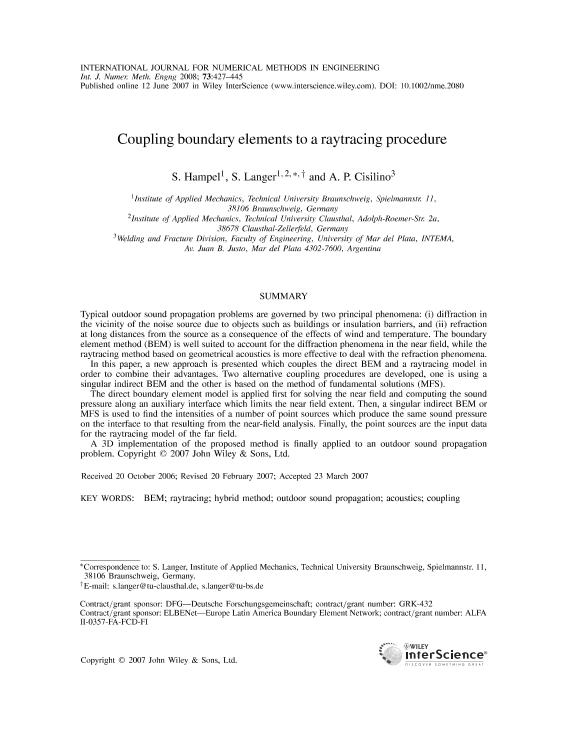Mostrar el registro sencillo del ítem
dc.contributor.author
Hampel, S.
dc.contributor.author
Langer, S.
dc.contributor.author
Cisilino, Adrian Pablo

dc.date.available
2019-06-24T15:53:51Z
dc.date.issued
2008-01
dc.identifier.citation
Hampel, S.; Langer, S.; Cisilino, Adrian Pablo; Coupling boundary elements to a raytracing procedure; John Wiley & Sons Ltd; International Journal for Numerical Methods in Engineering; 73; 3; 1-2008; 427-445
dc.identifier.issn
0029-5981
dc.identifier.uri
http://hdl.handle.net/11336/78720
dc.description.abstract
Typical outdoor sound propagation problems are governed by two principal phenomena: (i) diffraction in the vicinity of the noise source due to objects such as buildings or insulation barriers, and (ii) refraction at long distances from the source as a consequence of the effects of wind and temperature. The boundary element method (BEM) is well suited to account for the diffraction phenomena in the near field, while the raytracing method based on geometrical acoustics is more effective to deal with the refraction phenomena. In this paper, a new approach is presented which couples the direct BEM and a raytracing model in order to combine their advantages. Two alternative coupling procedures are developed, one is using a singular indirect BEM and the other is based on the method of fundamental solutions (MFS). The direct boundary element model is applied first for solving the near field and computing the sound pressure along an auxiliary interface which limits the near field extent. Then, a singular indirect BEM or MFS is used to find the intensities of a number of point sources which produce the same sound pressure on the interface to that resulting from the near-field analysis. Finally, the point sources are the input data for the raytracing model of the far field. A 3D implementation of the proposed method is finally applied to an outdoor sound propagation problem.
dc.format
application/pdf
dc.language.iso
eng
dc.publisher
John Wiley & Sons Ltd

dc.rights
info:eu-repo/semantics/openAccess
dc.rights.uri
https://creativecommons.org/licenses/by-nc-sa/2.5/ar/
dc.subject
Acoustics
dc.subject
Bem
dc.subject
Coupling
dc.subject
Hybrid Method
dc.subject
Outdoor Sound Propagation
dc.subject
Raytracing
dc.subject.classification
Ingeniería Arquitectónica

dc.subject.classification
Ingeniería Civil

dc.subject.classification
INGENIERÍAS Y TECNOLOGÍAS

dc.title
Coupling boundary elements to a raytracing procedure
dc.type
info:eu-repo/semantics/article
dc.type
info:ar-repo/semantics/artículo
dc.type
info:eu-repo/semantics/publishedVersion
dc.date.updated
2019-06-11T15:37:35Z
dc.journal.volume
73
dc.journal.number
3
dc.journal.pagination
427-445
dc.journal.pais
Reino Unido

dc.journal.ciudad
Londres
dc.description.fil
Fil: Hampel, S.. Technical University Braunschweig; Alemania
dc.description.fil
Fil: Langer, S.. Technical University Clausthal; Alemania
dc.description.fil
Fil: Cisilino, Adrian Pablo. Consejo Nacional de Investigaciones Científicas y Técnicas. Centro Científico Tecnológico Conicet - Mar del Plata. Instituto de Investigaciones en Ciencia y Tecnología de Materiales. Universidad Nacional de Mar del Plata. Facultad de Ingeniería. Instituto de Investigaciones en Ciencia y Tecnología de Materiales; Argentina
dc.journal.title
International Journal for Numerical Methods in Engineering

dc.relation.alternativeid
info:eu-repo/semantics/altIdentifier/url/https://onlinelibrary.wiley.com/doi/abs/10.1002/nme.2080
dc.relation.alternativeid
info:eu-repo/semantics/altIdentifier/doi/http://dx.doi.org/10.1002/nme.2080
Archivos asociados
